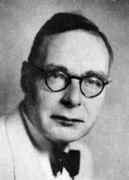Person: Kramers, Hendrik Anthony

Hendrik Kramers was a Dutch physicist who worked with Niels Bohr to understand how electromagnetic waves interact with matter.
Mathematical Profile (Excerpt):
- His parents were Hendrik Kramers, a doctor in Rotterdam, and Jeanne Susanne Breukelman.
- Kramers entered the University of Leiden in 1912 to study mathematics and physics.
- The Netherlands remained neutral during the war but it still had severe consequences for a young scientist like Kramers.
- At this point Kramers decided that he needed international experience but this was not easy given the fighting which engulfed much of Europe.
- Denmark was, like the Netherlands, neutral so Kramers decided to travel to Copenhagen and study with Niels Bohr.
- Nevertheless, travel by boat was the least bad option so Kramers took this route.
- Now Niels Bohr had only been confirmed as being appointed to a chair of theoretical physics in Copenhagen in April 1916 while he had been working with Rutherford in Manchester, England, and had returned to Copenhagen in the summer of that year, not long before Kramers arrived.
- Bohr agreed to have Kramers as a student and under his supervision he wrote his doctoral thesis Intensities of spectral lines: On the application of the quantum theory to the problem of the relative intensities of the components of the fine structure and of the Stark effect of the lines of the hydrogen spectrum which he submitted to the University of Leiden.
- Kramers also included the effect of fine structure involving corrections for relativistic kinetic energy and coupling between electron spin and orbit.
- In 1920 the Institute of Theoretical Physics opened in Copenhagen and Kramers, as Bohr's assistant, played a significant role in its establishment.
- In March 1924 Werner Heisenberg visited Kramers and Bohr at the Institute for Theoretical Physics in Copenhagen.
- At the heart of Kramers' theory are the correspondence principle and the so-called 'virtual field model' of the atom.
- Kramers returned to the Netherlands in 1926 when he accepted the position of professor of theoretical physics at the University of Utrecht.
- It was translated into English by Dirk ter Haar, a former student of Kramers, and published as Quantum mechanics in 1957.
- Another fascinating aspect, which is now not only of scientific but also of historical importance, is the discussion of the interaction between electrons and the radiation field, which Kramers had brought at the time of publication of his book to its most advanced pre-war state of development by recognizing the necessity of what is now called mass renormalization.
- In the following year Kramers was appointed to succeed Ehrenfest, and he gave his inaugural lecture on Physics and physicists on 28 September 1934.
- It became clear that the closure was not going to be a short one and Kramers, like the other professors, had to find an income from other sources.
- Kramers went to the company's offices in Amsterdam once a week.
- Kramers then resigned from the Royal Dutch Academy of Sciences in protest against the exclusion of Jews from the Academy.
- Pais, who was also a physicist, knew Kramers well and had visited him regularly in Leiden from the autumn of 1939.
- Kramers learnt about Pais' hiding place in Amsterdam and visited him every Monday evening after he had completed his consultation work at the Bataafsche Petroleum Maatschappij.
- Kramers said that my hiding period would be a good time for me to learn to play an instrument, and he offered to give me instruction on the cello, his personal favourite.
- Kramers was there at the time.
- Later Pais was captured by the Germans and Kramers wrote to Heisenberg asking him to intercede on Pais' behalf.
- Kramers received many honours for his outstanding contributions, and had he not died at a young age he would certainly have received further honours.
- Also in 1975 the University of Utrecht founded the Kramers Chair for Theoretical Physics.
Born 17 December 1894, Rotterdam, The Netherlands. Died 24 April 1952, Oegstgeest, The Netherlands.
View full biography at MacTutor
Tags relevant for this person:
Origin Netherlands
Thank you to the contributors under CC BY-SA 4.0! 

- Github:
-

- non-Github:
- @J-J-O'Connor
- @E-F-Robertson
References
Adapted from other CC BY-SA 4.0 Sources:
- O’Connor, John J; Robertson, Edmund F: MacTutor History of Mathematics Archive
